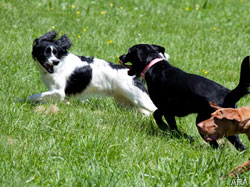
(ARA) – As you schedule flu shots for yourself and your children, you may want to consider doing the same for the canine members of the family.
If you haven’t heard of the canine influenza virus (CIV), or the dog flu, you are probably not alone – the disease was first identified in 2004. While humans typically line up for vaccinations in the fall to protect them during the colder months, dogs can get the disease at any time.
Dogs affected by a CIV infection experience a respiratory infection. For most dogs, it is a mild illness, but some get very sick and the disease can cause lingering health issues. Here are some things you should know about canine influenza:
* It’s highly contagious. Most dogs have not built up immunity to the disease because it’s relatively new. Dogs can get the disease by being exposed to dogs that have it, as well as playing with toys or drinking from bowls used by other dogs.
* Humans cannot contract the disease. But they can spread it through their clothing or other items that have come in contact with infected dogs.
* The virus has been detected in 34 states so far. Since it was first identified in Florida racing greyhounds in 2004, the disease has spread rapidly. Most states report some incidence of the disease, but it can be difficult to track because it’s hard to diagnose. To view where the dog flu has been found, visit www.doginfluenza.com.
* Dog flu is difficult to detect. Dogs become sick before they start showing symptoms, like coughing. Because it’s a relatively new disease, many veterinarians are not yet experienced in identifying it.
* The disease can be really serious. Most dogs recover from the dog flu, but some suffer secondary infections like pneumonia, which can be fatal. Many dogs suffer lung damage that may not be detectable in clinical examinations.
* Treating a dog for CIV is costly. Treatment costs can be significant, especially if your dog has to be hospitalized. For the owner of a boarding kennel, an outbreak is even more costly both in terms of money and reputation.
Fortunately, the discomforts and potential danger of dog flu can be mitigated, because there is a vaccine. The Nobivac Canine Flu H3N8 Vaccine was launched under a conditional license in 2009 and fully licensed by the USDA in 2010. Like human flu vaccine, it does not guarantee your dog won’t be infected, but it can significantly decrease the severity and spread of the dog flu.
By getting your dog vaccinated you can save on the potential costs of treating the disease, as well as promote canine health by helping prevent its spread. Clinics and boarders are also beginning to require the vaccine – 20 percent currently do, according to the 2010 Veterinary Economics “State of the Industry Study.”
Because the vaccine requires two doses the first year, given two to four weeks apart, it’s important to plan ahead if you are boarding or traveling with your dog. Starting the process six weeks ahead of when your dog may be exposed will allow the vaccine enough time to protect your dog.
The more social your dog, the more likely it will be exposed to the disease. By thinking about pet health this flu season, you can help ensure a longer and healthier life for your dog. So ask your veterinarian whether the canine flu vaccination is right for your dog.





